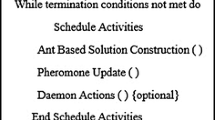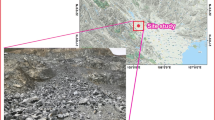Abstract
In blasting works, the aim is to provide proper rock fragmentation and to avoid undesirable environmental impacts such as back-break. Therefore, predicting fragmentation and back-break is a significant step in achieving a technically and economically successful outcome. In this paper, considering the robustness of artificial intelligence methods utilized in engineering problems, an artificial neural network (ANN) was applied to predict rock fragmentation and back-break; an artificial bee colony (ABC) algorithm was also utilized to optimize the blasting pattern parameters. In this regard, blasting parameters, including burden, spacing, stemming length, hole length and powder factor, as well as back-break and fragmentation were collected at the Anguran mine in Iran. Root mean square error (RMSE) values equal to 2.76 and 0.53 for rock fragmentation and back-break, respectively, reveal the high reliability of the ANN model. In addition, ABC algorithm results suggest values of 29 cm and 3.25 m for fragmentation and back-break, respectively. For comparison purposes, an empirical model (Kuz-Ram) was performed to predict the mean fragment size in the Anguran mine. A mean fragment size of 33.5 cm shows the ABC algorithm can optimize rock fragmentation with a high degree of accuracy.












Similar content being viewed by others
References
Atici U (2011) Prediction of the strength of mineral admixture concrete using multivariable regression analysis and an artificial neural network. Expert Syst Appl 38:9609–9618
Bagheri M, Khoshru H (2012) A new model for design of blasting pattern based on modified Kuz-Ram model in Gole- Gohar mine, Iran. In 1st technology conference of mining, Iran
Bahrami A, Monjezi M, Goshtasbi K, Ghazvinian A (2011) Prediction of rock fragmentation due to blasting using artificial neural network. Eng Comput 27(2):177–181
Bozorg Haddad O (2005) Hydro system optimization using bee colony algorithm, Ph.D thesis, university of science and technology, Iran
Cunningham CVB (1983) The Kuz-Ram model for prediction of fragmentation from blasting. In: Proceedings of the first international symposium on rock fragmentation by blasting, Lulea, Sweden, pp 439–453
Cunningham CVB (1987) Fragmentation estimations and the Kuz-Ram model-Four years on. In: Proc. 2nd Int. Symp. on Rock Fragmentation by Blasting, pp 475–487
Dreyfus G (2005) Neural networks: methodology and application. Springer, Berlin
Du KL, Lai AKY, Cheng KKM, Swamy MNS (2002) Neural methods for antenna array signal processing: a review. Signal Process 82:547–561
Esmaeili M, Osanloo M, Rashidinejad F, Bazzazi AA, Taji M (2012) Multiple regression, ANN and ANFIS models for prediction of backbreak in the open pit blasting. Eng Comput. doi:10.1007/s00366-012-0298-2
Görgülü K, Arpaz E, Demirci A, Koçaslan A, Dilmaç MK, Yüksek AG (2013) Investigation of blast-induced ground vibrations in the Tülü boron open pit mine. Bull Eng Geol Environ 72(3–4):555–564
Hajihassani M, Jahed Armaghani D, Marto A, Tonnizam Mohamad E (2014a) Ground vibration prediction in quarry blasting through an artificial neural network optimized by imperialist competitive algorithm. Bull Eng Geol Environ. doi:10.1007/s10064-014-0657-x
Hajihassani M, Jahed Armaghani D, Sohaei H, Tonnizam Mohamad E, Marto A (2014b) Prediction of airblast-overpressure induced by blasting using a hybrid artificial neural network and particle swarm optimization. Appl Acoust 80:57–67
Jahed Armaghani D, Hajihassani M, Mohamad ET, Marto A, Noorani SA (2013) Blasting-induced flyrock and ground vibration prediction through an expert artificial neural network based on particle swarm optimization. Arab J Geosci. doi:10.1007/s12517-013-1174-0
Jahed Armaghani D, Hajihassani M, Yazdani Bejarbaneh B, Marto A, Tonnizam Mohamad E (2014a) Indirect measure of shale shear strength parameters by means of rock index tests through an optimized artificial neural network. Measurement 55:487–498
Jahed Armaghani D, Tonnizam Mohamad E, Momeni E, Narayanasamy MS, Mohd Amin MF (2014b) An adaptive neuro-fuzzy inference system for predicting unconfined compressive strength and Young’s modulus: a study on main range granite. Bull Eng Geol Environ. doi:10.1007/s10064-014-0687-4
Jimeno CL, Jimeno EL, Carcedo FJA (1995) Drilling and blasting of rocks. Balkema, Rotterdam
Kalinli A, Acar MC, Gunduz Z (2011) New approaches to determine the ultimate bearing capacity of shallow foundations based on artificial neural networks and ant colony optimization. Eng Geol 117:29–38
Karaboga D (2005) An idea based on honey bee swarm for numerical optimization, Technical Report-TR06, Erciyes University, Engineering Faculty, Computer Engineering Department
Khandelwal M, Monjezi M (2013) Prediction of backbreak in open-pit blasting operations using the machine learning method. Rock Mech Rock Eng 46(2):389–396
Kisi O, Ozkan C, Akay B (2012) Modeling discharge—sediment relationship using neural networks with artificial bee colony algorithm. J Hydrol 428:94–103
Kuo RJ, Wang YC, Tien FC (2010) Integration of artificial neural network and MADA methods for green supplier selection. J Clean Prod 18(12):1161–1170
Michaux S, Djordjevic N (2005) Influence of explosive energy on the strength of the rock fragments and SAG mill throughput. Min Eng 18(4):439–448
Mohammadnejad M, Gholami R, Sereshki F, Jamshidi A (2013) A new methodology to predict backbreak in blasting operation. Int J Rock Mech Min Sci 60:75–81
Momeni E, Jahed Armaghani D, Hajihassani M, Mohd Amin MF (2015) Prediction of uniaxial compressive strength of rock samples using hybrid particle swarm optimization-based artificial neural networks. Measurement 60:50–63
Monjezi M, Rezaei M, Yazdian Varjani A (2009) Prediction of rock fragmentation due to blasting in Gol-E-Gohar iron mine using fuzzy logic. Int J Rock Mech Min Sci 46(8):1273–1280
Monjezi M, Bahrami A, Yazdian Varjani A (2010a) Simultaneous prediction of fragmentation and flyrock in blasting operation using artificial neural networks. Int J Rock Mech Min Sci 47(3):476–480
Monjezi M, Rezaei M, Yazdian A (2010b) Prediction of backbreak in open-pit blasting using fuzzy set theory. Expert Syst Appl 37(3):2637–2643
Monjezi M, Khoshalan HA, Varjani AY (2012) Prediction of flyrock and backbreak in open pit blasting operation: a neuro-genetic approach. Arab J Geosci 5(3):441–448
Monjezi M, Hasanipanah M, Khandelwal M (2013) Evaluation and prediction of blast-induced ground vibration at Shur River Dam, Iran, by artificial neural network. Neural Comput Appl 22:1637–1643
Monjezi M, Rizi SH, Majd VJ, Khandelwal M (2014) Artificial neural network as a tool for backbreak prediction. Geotech Geol Eng 32(1):21–30
Raina AK, Murthy VMSR, Soni AK (2014) Flyrock in bench blasting: a comprehensive review. Bull Eng Geol Environ. doi:10.1007/s10064-014-0588-6
Sayadi A, Monjezi M, Talebi N, Khandelwal M (2013) A comparative study on the application of various artificial neural networks to simultaneous prediction of rock fragmentation and backbreak. J Rock Mech Geotech Eng 5(4):318–324
Shahin MA, Maier HR, Jaksa MB (2002) Predicting settlement of shallow foundations using neural networks. J Geotech Geoenviron Eng 128(9):785–793
Simpson PK (1990) Artificial neural system: foundation, paradigms, applications and implementations. Pergamon, New York
Thornton D, Kanchibotla SS, Brunton I (2002) Modelling the impact of rock mass and blast design variation on blast fragmentation. Int J Blast Fragm 6(2):169–1168
Tonnizam Mohamad E, Hajihassani M, Jahed Armaghani D, Marto A (2012) Simulation of blasting-induced air overpressure by means of artificial neural networks. Int Rev Model Simul 5(6):2501–2506
Tonnizam Mohamad E, Jahed Armaghani D, Momeni E, Alavi Nezhad Khalil, Abad SV (2014) Prediction of the unconfined compressive strength of soft rocks: a PSO-based ANN approach. Bull Eng Geol Environ. doi:10.1007/s10064-014-0638-0
Zheming X, Mohanty B, Heping Z (2007) Numerical investigation of blasting- induced crack initiation and propagation in rocks. Int J Rock Mech Min Sci 44:412–424
Zhu HT, Huang CZ, Wang J, Lu XY (2008) Machinability of glass by abrasive waterjet. Int J Mater Product Technol 31(1):106–112
Author information
Authors and Affiliations
Corresponding author
Rights and permissions
About this article
Cite this article
Ebrahimi, E., Monjezi, M., Khalesi, M.R. et al. Prediction and optimization of back-break and rock fragmentation using an artificial neural network and a bee colony algorithm. Bull Eng Geol Environ 75, 27–36 (2016). https://doi.org/10.1007/s10064-015-0720-2
Received:
Accepted:
Published:
Issue Date:
DOI: https://doi.org/10.1007/s10064-015-0720-2




